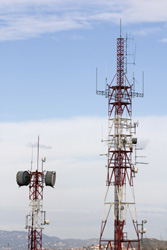Simultaneous use in wireless communications
The remarkable benefits for end users and service providers of wireless communication systems with antenna arrays at both transmitters and receivers has motivated research work conducted within the FLOWS project. To enable the full range of interactive services like e-mail, multimedia messaging, Internet browsing and wireless positioning, reliable and fast transmission of information over the air is required. These so-called multiple-input multiple-output (MIMO) systems have already been shown to yield tremendous capacity, which grows at least linearly with the number of transmit and receive antennas. Aiming to enhance the MIMO up-link designed to operate under third generation cellular standards, new multi-user interference cancellation techniques have been proposed by project partners at the University of York. Based on estimates of each user's modulated signal and channel noise, the desired received data was sought to be more accurately and importantly, simultaneously evaluated by subtracting the undesired interference. For this purpose, they were interested in combining the benefits of forward error control coding with the information capacity of MIMO channels. With only limited increase in decoding complexity, space-time turbo coded interference cancellation enabled a large, systematic increase in coding gains while preserving the performance advantages of MIMO channels. Merging appropriate channel coding with antenna diversity at each end of the uplink, the multi-user detection scheme proposed has been proven to be effective for combating co-channel interference. Moreover, residual interference could be suppressed in each iteration, leading to an increase of the MIMO system's capacity.



